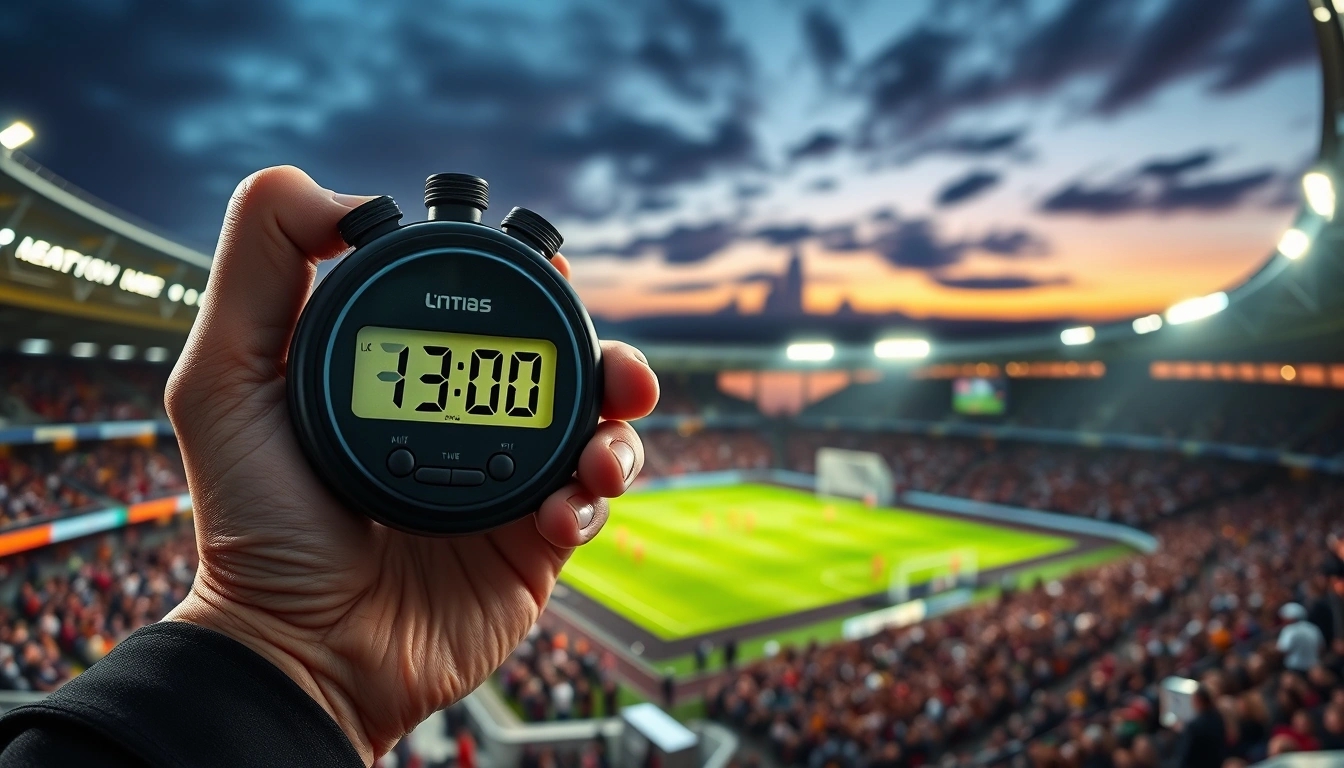Ever noticed how those final minutes after the 90th can feel like they stretch into eternity? You’re not alone. It’s like the clock just stops making sense, and the referee seems to have a secret stash of minutes up their sleeve. So, what’s really going on behind the scenes when refs add that mysterious “extra time”? Let’s unpack this whole saga and see why they can’t just blow the whistle right on the dot.
The Basics of Added Time
First things first: added time isn’t just some cruel joke to torture fans or drag the game longer. It’s officially called “stoppage time” or “injury time,” and its main job is to make up for all the moments the clock was paused — or should have been paused — during the regular 90 minutes. Think injuries, substitutions, time-wasting antics, and even VAR checks. Without this, teams could lose precious seconds, and the game wouldn’t be fair. So, added time is basically the referee’s way of saying, “Hey, let’s make sure the full game is actually played.”
- Injuries: When a player goes down, the clock doesn’t stop, but the game does. That lost time? It gets added back.
- Substitutions: Bringing on fresh legs takes a minute or two, and that counts too.
- VAR reviews: Those video checks can drag on, so refs compensate.
- Time-wasting: When teams slow down the game intentionally, refs try to balance that out.
How Do Refs Actually Calculate This Time?
If you think referees just pull numbers out of thin air, think again. They have a pretty methodical approach. The main official keeps track of all stoppages during the half, while the fourth official usually holds up the board showing the minimum added minutes. But here’s the catch: it’s always a minimum. Refs can add more if things get messy in those final moments — like a red card or a penalty. So, it’s a bit like judging a cooking contest while simultaneously juggling knives — tricky and prone to debate.
| Event | Typical Added Time | Why It Matters |
|---|---|---|
| Injury | 1-3 minutes | Lost playtime due to treatment |
| Substitution | 30 seconds to 1 minute | Time taken for player changes |
| VAR Check | Varies (1-5 minutes) | Video review delays |
| Time-wasting | Added as needed | Discourages deliberate delays |
Why Do Fans and Players Get So Worked Up?
Honestly, added time is the ultimate drama factory. That extra slice of minutes can flip the script — last-minute goals, penalties, heartbreaks — it’s like football’s version of a cliffhanger. Some fans scream at their screens, convinced the ref is “stealing” time or favoring one team. Players? They either sprint like mad or collapse in despair, depending on which side of fortune they’re on. It’s messy, emotional, and absolutely part of the beautiful game’s charm.
Quick Recap:
- Added time compensates for stoppages.
- Referees calculate it on the fly, but it’s always a minimum.
- It can add drama, controversy, and unexpected twists.
So next time you’re biting your nails during those “extra” minutes, remember: the clock might be ticking down, but the game’s story isn’t over yet. And referees? They’re just trying to keep things fair — even if it feels like they’re messing with your nerves.
The Basics of Added Time
So, what’s the deal with added time in football? It’s that mysterious stretch of minutes tacked onto the end of a match, making fans sweat bullets and players push their limits. But here’s the kicker: added time isn’t some random punishment or a cruel joke on supporters who just want the game to end already. Nope, it’s actually a crucial part of keeping the game fair and square.
Think about it — during the regular 90 minutes, the clock doesn’t stop for every little thing. Substitutions, injuries, time-wasting tactics, VAR checks — all these slow the game down, eating into the actual playing time. So referees add extra minutes to compensate for that lost time, making sure teams get their full dose of action. It’s like when you pause your favorite show and want to catch up later — football tries to do the same.
- Why is added time important? Because without it, the match could end prematurely, shortchanging players and fans alike.
- Who decides how much time is added? The referee, with a bit of help from the fourth official and sometimes tech tools like VAR.
- Is added time always accurate? Well, not really. It’s a bit of an art and a science, and refs sometimes get it wrong, which fuels endless debates.
| Cause | Typical Added Time (minutes) | Why It Matters |
|---|---|---|
| Injuries | 1-3 | Players need treatment, and the clock keeps ticking. |
| Substitutions | 0.5-2 | Changing players takes time, slowing the game. |
| VAR Reviews | 1-5 | Technology checks can be lengthy but necessary. |
| Time Wasting | Varies | Players trying to kill the clock get penalized with more added time. |
Now, here’s where it gets a bit tricky. The referee is the ultimate timekeeper, but unlike a basketball game where the clock stops and starts, football’s clock runs continuously. So, the ref has to keep mental notes of all the stoppages and add a fair amount at the end. Sometimes, it feels like they’re guessing, especially when the board shows 4 minutes but the ref blows the whistle after 6. Cue the angry fans and conspiracy theories!
But despite the grumbles, added time is a lifeline for fairness. It ensures that no team loses precious moments due to unforeseen delays. Plus, those extra minutes often bring the most drama — last-gasp goals, frantic saves, and heart-stopping moments that define careers.
Quick tip for fans: Don’t just watch the 90 minutes. Stay glued till the very end because added time is where legends are made and heartbreaks unfold.
In the end, added time might seem like a headache or a cruel extension of torture, but it’s actually football’s way of saying, “Let’s be fair and give everyone their full shot.” So next time you’re biting your nails during those extra minutes, remember — it’s not just added time, it’s football’s built-in justice system.
Common Reasons for Extra Time
Ever been glued to your screen, heart pounding, only to find the referee holding up that infamous board for what feels like an eternity? Yeah, we all have. But what’s really going on behind the scenes that forces refs to stretch the clock beyond the usual 90 minutes? Let’s break down the usual suspects that make extra time linger like an uninvited guest at a party.
- Injuries and Medical Timeouts
Nothing kills the flow quite like a player suddenly crumpling to the ground. Whether it’s a twisted ankle or a nasty collision, the ref has to stop the game for treatment. And let’s be honest, sometimes it feels like the medics are performing a full-on surgery on the pitch! All that time lost? It’s tacked onto the end, because fairness demands the clock stops when the ball isn’t rolling. - Substitutions
Every time a team decides to shuffle players, the clock takes a little nap. Subbing out tired legs or tactical switches means the ref waves the game off for a minute or two. If you’ve ever seen a team make three substitutions in a row, you know exactly why the fourth official’s board stays up longer than your favorite TV show’s commercial break. - VAR Reviews and Goal Celebrations
Ah, the modern headache: VAR. Video Assistant Referees are brilliant, but they do slow things down. When a goal is scored or a contentious foul happens, refs pause the game to check the replay. And when a goal does stand, the celebrations can drag on—because who wants to rush the moment when your team just found the back of the net?
| Reason | Average Added Time (per incident) | Why It Happens |
|---|---|---|
| Injuries | 1-3 minutes | Stopping play for treatment and stretcher carry-offs |
| Substitutions | 30 seconds – 1 minute | Player changes require pause and setup |
| VAR Checks | 1-4 minutes | Reviewing footage for critical decisions |
| Time-Wasting | Varies | Players deliberately delaying restarts |
Now, not everything that eats up time is as straightforward as a player down or a sub coming on. Sometimes, it’s the sneaky little things—like players taking forever to get up or the ref having a quick word with a grumpy defender—that add up. And let’s not forget about the occasional pitch invasion or fan shenanigans that can halt the game entirely. Yeah, that’s a thing.
- Time-Wasting Tactics
You know the drill: a defender takes an eternity to kick the ball out for a throw-in, or the goalie suddenly needs a long chat with the ref. It’s all part of the game’s chess match, trying to kill clock when a team’s clinging to a lead. The ref’s got to keep an eye on this and add time accordingly, or else the losing side would never get a fair shot. - Other Interruptions
Weather delays, broken equipment, or even a stray animal on the pitch can cause unexpected pauses. While rare, these moments still count as lost time that must be made up to keep the game honest.
So, next time you’re wondering why the ref is dragging out the final moments, remember: it’s not just to torture fans or mess with your nerves. It’s about making sure every second of the game is played fairly, respecting the effort, drama, and chaos that football throws at us. Because in the end, those extra minutes might just be the ones that decide everything.

How Referees Calculate Added Time
Alright, so you’re sitting there, watching the clock tick past the 90-minute mark, and you’re thinking, “Why on earth is the ref holding up that board with a big ol’ number on it?” Spoiler alert: it’s not just some wild guess or a sneaky move to torture fans. Referees actually have a method to the madness when it comes to deciding how much extra time to add at the end of a match. But don’t expect a stopwatch and a calculator magically appearing on the pitch—it’s a tricky, real-time juggling act.
First off, added time (sometimes called stoppage time or injury time) is meant to compensate for all those little moments when the clock stops ticking during the game. Think injuries, substitutions, time-wasting tactics, VAR checks, and even goal celebrations. The ref’s job is to keep the game fair by making sure teams get their full playing time, even if the clock doesn’t run continuously.
| Common Causes of Added Time | Typical Time Added |
|---|---|
| Player Injuries & Medical Attention | 1-3 minutes |
| Substitutions | 30 seconds to 1 minute each |
| VAR Checks and Reviews | 1-3 minutes |
| Time-wasting by Players | Varies, depends on referee’s discretion |
| Goal Celebrations | 30 seconds to 1 minute |
Now, how does the ref keep track of all this? They don’t have a team of assistants whispering in their ear every second. Instead, the referee, along with the fourth official, keeps mental notes throughout the match. The fourth official usually holds up the board showing added time, but it’s the referee who calls the shots on the exact amount. Some refs might be stricter, others more lenient, which explains why added time can feel like a bit of a lottery.
- Mental bookkeeping: Referees tally up all stoppages as the game progresses.
- Consultation: They often check in with the fourth official or assistant refs for input.
- Discretion: Final call is theirs, balancing fairness with game flow.
And here’s the kicker: the time shown is the minimum amount of added time. The ref can extend it further if more delays happen during stoppage time itself. So if you’re thinking the ref just waves the game off after the board goes up, nope! They’re glued to the action, ready to add seconds or even a minute more if needed.
Honestly, it’s a tough gig. Imagine trying to keep track of every single delay while watching 22 players run around like maniacs, the crowd roaring, and the pressure mounting. Sometimes refs get it right, sometimes they don’t — and that’s part of the drama that keeps football fans talking long after the final whistle.
In short, added time isn’t guesswork, but it’s also not an exact science. It’s a mix of experience, awareness, and a bit of gut feeling. Next time you grumble about those extra minutes, remember the refs are just trying to keep the game fair while dealing with chaos on the pitch.
Controversies Around Added Time
Ah, added time – the moment when every fan’s heart either soars or sinks, and players suddenly look like they’ve been running a marathon. But why do these extra minutes cause such chaos, and do referees actually get it right more often than not? Let’s unpack this mess.
First off, fans losing their minds over added time is almost a tradition by now. You’re sitting there, clutching your snacks, thinking the game’s about to end, and then bam! The ref waves his arm and yells “Four minutes added!” Suddenly, everyone’s on edge. Why? Because those extra minutes can feel like an eternity, especially if the score is tight. It’s like the ref’s holding the game hostage, stretching the tension just to mess with your nerves. And players? They’re scrambling, some desperate to score, others praying the whistle blows any second.
- Why the fuss? Added time isn’t just a random number. It’s supposed to compensate for delays – injuries, substitutions, time-wasting, VAR checks, you name it.
- But here’s the kicker: The ref is the only one deciding how much time to add. No stopwatch, no official countdown. Just gut feeling and experience.
This leads us to the biggest gripe: subjectivity. Fans and players alike question whether refs are being fair or sneaky. Ever noticed how sometimes just a minor injury can add several minutes, but other times blatant time-wasting barely gets a minute? That inconsistency fuels conspiracy theories – “They’re favoring the home team!” or “They’re letting the big clubs off easy!”
| Common Reasons for Added Time | Typical Duration Added |
|---|---|
| Player Injuries | 1-3 minutes |
| Substitutions | 30 seconds to 1 minute each |
| VAR Checks | Varies widely (1-5 minutes) |
| Time Wasting | Depends on severity; often 1-3 minutes |
Now, do referees get it right more often than not? The honest answer: it’s a mixed bag. Some refs are masters at reading the game and managing time, while others seem to add extra minutes like they’re guessing the lottery numbers. The pressure is enormous – get it wrong, and you’re the villain of the day. But remember, refs have to juggle so many things simultaneously: player behavior, game flow, crowd atmosphere, plus the clock.
Sometimes, the added time feels generous – like when a team scores a last-gasp winner. Other times, it’s painfully stingy, leaving fans and players furious. And let’s not forget the psychological warfare: teams leading might try to milk every second, while trailing sides are praying for just a sliver more time to snatch a goal.
In short: Added time is as much an art as a science. It’s imperfect, often controversial, and guaranteed to stir emotions. But hey, isn’t that part of football’s charm? Without those nail-biting extra minutes, would the game be as thrilling? Probably not.
- Practical tip for fans: Always expect the unexpected – the ref’s watch is never the same as yours.
- For players: Stay sharp until the very last whistle; added time can change everything.
So next time you’re screaming at the screen because the ref added “too much” time, remember – it’s messy, imperfect, but it’s just part of the beautiful game’s drama.
Impact of Added Time on Match Outcomes
Ever been at the edge of your seat, heart pounding, as the referee signals for added time? That extra slice of minutes after the 90 can feel like an eternity, and boy, does it have the power to turn the entire game upside down. You think the match is all wrapped up, the players are already heading back to the locker rooms, but then BAM! A last-gasp goal or a penalty in added time flips the script completely. It’s like football’s version of a plot twist you never saw coming.
Added time isn’t just some random extension thrown in to mess with fans’ nerves (although, let’s be honest, it does that pretty well). It’s there to compensate for all the stoppages during the game—injuries, substitutions, time-wasting antics, VAR checks, you name it. But here’s the kicker: those few extra minutes can change everything. A team that’s been on the back foot suddenly finds a burst of energy, and a desperate equalizer or a cheeky winner can send the crowd into pandemonium.
| Common Outcomes Influenced by Added Time | Examples |
|---|---|
| Last-minute goals | Think Sergio Agüero’s iconic 2012 Premier League winner for Man City |
| Crucial penalties awarded | High-pressure moments that decide knockout rounds |
| Momentum shifts | Teams gaining confidence or losing composure |
| Psychological impact | Players’ nerves and stamina tested to the limit |
Now, it’s not always sunshine and roses. Sometimes, added time feels like a cruel joke. Imagine being a team that’s been defending for dear life, only for the ref to tack on a suspiciously long 6 minutes. Fans start grumbling, players get edgy, and the tension is thicker than a foggy London morning. Yet, that’s football for you—unpredictable, unfair, and utterly thrilling.
- Why does added time matter so much? Because football isn’t just 90 minutes flat. It’s a game of inches, seconds, and moments that can come out of nowhere.
- What’s the psychological toll? Players are mentally drained, coaches frantic, and fans biting their nails.
- Can added time be a blessing or a curse? Absolutely. For some, it’s a chance to snatch glory; for others, a heartbreak waiting to happen.
Let’s not forget the drama VAR brings during added time. Video assistant referees sometimes extend the agony, reviewing incidents that can either confirm a goal or disallow it, adding layers of suspense but also frustration. The clock keeps ticking, and so does the pressure.
In the end, added time is football’s wild card. It’s where legends are born, where heroes rise, and where heartbreaks echo through stadiums long after the final whistle. So next time you see those digits flashing on the board, buckle up—because the game isn’t over until the ref says it is.
Quick Takeaway:
Added Time Opportunity + Risk + DramaIt’s the unpredictable spice that keeps football fans hooked, reminding us all that in this beautiful game, every second counts—especially the ones after the clock runs out.

Technological Help in Timekeeping
Alright, let’s talk about the tech tools that have stormed onto the football scene, shaking up how referees keep track of that all-important added time. You know, those moments after the 90 minutes that can either feel like a blink or drag on forever depending on what’s happening. It’s not just the ref’s watch anymore—oh no, now we have VAR, fourth officials, and a bunch of gizmos trying to make sure the game’s clock is as fair as possible. But honestly? Sometimes it feels like they’re just adding to the chaos.
First up, VAR (Video Assistant Referee). This fancy system reviews big decisions—penalties, red cards, goals—and yes, the time lost during these checks is supposed to be added on at the end. But here’s the kicker: while VAR aims to bring clarity, it often drags the game out, leaving fans biting their nails and players pacing nervously. The ref has to estimate how long these pauses take and add that to the clock. Sounds simple, right? Well, not quite. There’s always debate about whether the right amount of time is tacked on, especially when VAR reviews can feel like they last an eternity.
| Technology | Role in Added Time | Pros | Cons |
|---|---|---|---|
| VAR | Reviews incidents; time lost added to stoppage time | Improves fairness | Can cause lengthy delays and confusion |
| Fourth Official | Displays added time on the board | Clear communication to players and fans | Relies on referee’s judgment; sometimes inconsistent |
| Goal-line Technology | Determines goals; minimal impact on timekeeping | Accurate goal decisions | Not directly linked to added time |
Now, onto the fourth official, who’s like the unsung hero of timekeeping. This person waves the board showing how many minutes are added, but guess what? They’re not the ones deciding the time. That’s still down to the main referee, who’s juggling a million things on the pitch—injuries, substitutions, time-wasting, and more. The fourth official just relays the number. Sometimes they update it if the ref signals for more time, which can lead to fans thinking, “Wait, what? More time again?” Yep, that’s why added time can feel like it’s stretching forever.
- Injuries: Time taken to treat players is added on.
- Substitutions: Every sub eats up precious seconds.
- VAR reviews: These pauses get tacked on too.
- Time-wasting: If a team’s trying to kill the clock, refs add time to balance it out.
Here’s where it gets tricky: even with all this tech, the decision on how much time to add isn’t an exact science. It’s more like an art form mixed with a bit of guesswork. The referee’s got to keep an eye on everything and then make a call that’s hopefully fair. Sometimes it works, sometimes it sparks outrage. Remember that classic moment when the ref added a ridiculous amount of time, and fans lost their minds? Yeah, tech can’t fix everything.
In short, technology has definitely helped make timekeeping more transparent and fair, but it’s far from perfect. Sometimes it just adds layers of confusion, especially when different officials and systems don’t quite sync up. So next time you’re watching those nail-biting extra minutes, remember: behind the scenes, there’s a whole team and a bunch of gadgets trying to keep the game ticking—and sometimes, it’s a bit of a mess.
In conclusion: Technology in timekeeping is a double-edged sword—bringing fairness but also complexity. And as football keeps evolving, so will these tools. Whether that’s a good thing or just another headache? Time will tell.
Differences in Added Time Across Leagues
Not all football leagues are cut from the same cloth when it comes to added time. You might think it’s a straightforward thing — a few minutes tacked on for stoppages — but oh no, it’s a whole different ball game depending on where you’re watching. Some leagues are stingy with the extra minutes, while others seem to throw the kitchen sink at the clock. Let’s unpack this weird, wonderful world of added time quirks.
First off, the English Premier League (EPL) is notorious for its “generous” added time. Referees here often add anywhere from 3 to 6 minutes, sometimes more if there’s a lot going on — injuries, VAR checks, or just plain chaos on the pitch. But here’s the kicker: the fourth official’s board only shows the minimum added time, so you might be stuck watching for longer than you bargained for. Frustrating? Sure. But hey, that’s football drama for you.
| League | Typical Added Time | Notable Quirks |
|---|---|---|
| English Premier League | 3-6 minutes | Minimum time shown; VAR often extends time |
| La Liga (Spain) | 2-5 minutes | Refs sometimes add less, quick restarts encouraged |
| Serie A (Italy) | 4-7 minutes | Longer stoppages due to tactical substitutions |
| Bundesliga (Germany) | 2-4 minutes | Generally strict with time; less drama |
| Ligue 1 (France) | 3-5 minutes | Moderate added time; VAR impact varies |
Over in Spain’s La Liga, the vibe is a bit different. Referees often keep added time tighter, usually hovering around 2 to 5 minutes. They tend to favor quick restarts and less time-wasting theatrics — at least in theory. But don’t get me wrong, they still have their moments where the clock seems to stretch like taffy. Tactical fouls and substitutions do eat into the clock, but the refs here seem to have a knack for keeping things moving.
Italy’s Serie A is a whole different beast. Known for its tactical chess matches, the added time often reflects that complexity. You can expect 4 to 7 minutes being added regularly, especially with the slow-mo substitutions and injury treatments. Serie A refs aren’t shy about letting the clock run if the game’s intensity demands it, which sometimes feels like an eternity for the fans.
- Bundesliga: This league is all about efficiency. Added time is usually on the shorter side, around 2-4 minutes. The referees here don’t tolerate much time-wasting, and the game flows pretty smoothly.
- Ligue 1: French football sits somewhere in the middle. Added time is moderate, and VAR’s influence can swing the numbers up or down depending on how many reviews are needed.
So, why do these differences exist? Well, it boils down to each league’s culture, referee training, and even fan expectations. Some leagues embrace added time as part of the spectacle, while others try to keep it tight to maintain flow. Plus, the use of technology like VAR can either lengthen or shorten added time depending on how it’s implemented.
Key Factors Influencing Added Time Across Leagues:- Referee discretion and style- VAR and technology usage- Game tempo and tactical play- Injury and substitution frequency- League regulations and traditions
At the end of the day, added time is a bit like jazz — unpredictable and full of surprises. Whether you’re a fan in England biting your nails through 6 extra minutes or in Germany hoping the ref keeps it brief, it’s just part of the beautiful game’s charm. And hey, sometimes that extra minute brings the most unforgettable moments — a last-gasp goal, a dramatic save, or a heart-stopping penalty.
So next time you’re watching a match and the ref signals for added time, remember: it’s not just minutes on a clock. It’s a reflection of the league’s personality, the game’s rhythm, and sometimes, pure football madness.
In summary:
- Added time varies significantly by league.
- Referee approach and technology impact the length.
- Fans’ patience is tested differently around the world.
- Added time can make or break the drama of a match.
Player and Coach Reactions to Added Time
Extra time in football—oh, what a rollercoaster! Some players and coaches practically live for those added minutes, while others look like they’d rather be anywhere else but stuck in that limbo. It’s like a coin toss whether you’ll be celebrating a last-gasp winner or cursing the delay that’s sucking the life out of your legs.
Why Some Love It
For certain players, extra time is a golden opportunity. Imagine being down by a goal and suddenly getting a few more precious minutes to turn the tide. That’s adrenaline, hope, and sheer determination all wrapped into one. Coaches, too, see it as a chance to tweak tactics, bring fresh legs on, or simply buy time for their team to regroup.
- Strikers: They often thrive on the unpredictability, sensing that moment to pounce.
- Defenders: Some get nervous, but others relish the challenge of holding their nerve.
- Coaches: Extra time means more chess moves, and for some, that’s where the game really begins.
The Other Side of the Coin
But let’s not sugarcoat it—extra minutes can be a nightmare. Fatigue kicks in, focus wavers, and frustration bubbles up. Players hate the uncertainty; you think the whistle is about to blow, and then bam!—another minute. Or two. Or five. It’s mentally draining, and coaches often look like they’re counting down seconds on their fingers.
| Reaction | Who Feels This Way? | Why? |
|---|---|---|
| Excited | Attacking players, optimistic coaches | Extra chance to score or change tactics |
| Frustrated | Fatigued players, defensive coaches | Physical exhaustion and mental uncertainty |
| Anxious | Goalkeepers, players protecting a lead | Pressure to hold the result with nerves on edge |
Emotions Run High
You’ll often see players gesturing wildly at the referee, begging for just a few seconds more or less. Coaches pace the sidelines, sometimes shouting instructions that sound like a broken record. The tension is tangible, and honestly, it’s part of what makes football so addictive.
Player: "Come on ref, just blow the whistle already!"Coach: "Keep your heads, lads! Two more minutes and we’re golden."Player: "I swear my legs have turned to jelly..."
In the end, extra time is a wild card. It can be a blessing or a curse, depending on which side of the pitch you’re standing. But one thing’s for sure—those added minutes make football unpredictable, thrilling, and downright human.
So next time you see the fourth official holding up that board, remember—it’s not just time being added; it’s drama, hope, despair, and everything in between coming to life.

Future of Added Time: Will It Change?
Football’s added time—love it or hate it—is one of the sport’s most unpredictable moments. You’re sitting there, heart pounding, thinking the game’s done, and then bam! The ref waves his arm, and suddenly, you’re in for an extra five minutes (or sometimes what feels like an eternity). But with the game evolving faster than you can say “VAR controversy,” what’s next for this nail-biting period? Will we ever see a perfect system, or is added time doomed to remain a guessing game? Let’s chew on that.
First off, let’s get real: referees are human. They’re juggling injuries, substitutions, time-wasting, and the occasional argument with a player who’s just been told to “calm down.” Calculating added time isn’t as simple as setting a stopwatch and calling it a day. It’s messy. And that’s why we get those infamous “five minutes added” moments that stretch on and on, leaving fans both thrilled and frustrated.
- Possible Rule Tweaks: Some football pundits and officials have floated ideas like a stop-clock system, similar to basketball, where the clock pauses for stoppages. Sounds neat, right? But imagine the chaos—would fans still get the same adrenaline rush? Would it slow down the game? That’s the million-dollar question.
- Automated Timekeeping: Technology is creeping into every corner of football. Could we see AI-powered timekeeping that tracks every second lost and adds it precisely? While tempting, it risks stripping away the human element and might create even more disputes.
- Standardized Added Time: Some suggest fixed added time per event (e.g., 30 seconds per substitution). This could make things transparent but might ignore the flow and context of the game.
| Change | Pros | Cons |
|---|---|---|
| Stop-Clock System | Precise timekeeping; less time-wasting | Disrupts game flow; unfamiliar to fans |
| AI-Powered Timekeeping | Objective and accurate; reduces human error | Technical glitches; loss of referee discretion |
| Fixed Added Time per Event | Transparency; easier to track | Ignores match context; might encourage time-wasting |
Now, will refs ever get it perfectly right? Honestly, probably not. The beauty and agony of football lie in its unpredictability. If added time was a strict science, it might lose some of its charm. Plus, players and coaches love to push the boundaries—expect more theatrics and gamesmanship if added time becomes too regimented.
In short, the future of added time is a mixed bag. We might see tweaks here and there, maybe a dash of tech, but the core challenge remains: balancing fairness, excitement, and the human touch. Until then, brace yourself for those nerve-wracking final minutes—because in football, the clock might be ticking, but the drama never stops.
- Quick takeaway: Added time will evolve, but it’s unlikely to become a perfect science anytime soon.
- Fan tip: Always expect the unexpected in those final moments—they’re what make football, well, football.
Frequently Asked Questions
- Why do referees add extra time at the end of a match?
Ever noticed how the clock doesn’t just stop at 90 minutes? Referees add extra time to compensate for any stoppages during the game—like injuries, substitutions, or time-wasting tactics. It’s their way of making sure the full, fair amount of play actually happens, so no one feels short-changed.
- How is the amount of added time decided?
It’s not a random guess! Referees keep track of delays throughout the match and add those minutes at the end. They consider things like player injuries, VAR reviews, and substitutions. Think of it as a referee’s mental calculator balancing fairness and flow.
- Can extra time influence the outcome of a game?
Absolutely! Those extra minutes can be game-changers—literally. Last-minute goals, penalties, or dramatic saves often happen during added time, flipping the script and sending fans into a frenzy. It’s where heroes are made and heartbreaks happen.
- Why do some leagues add more extra time than others?
Different leagues have their own style and rules about timekeeping. Some are stricter about stopping the clock, while others let the game flow more naturally. This means the amount of added time can vary, reflecting each league’s unique approach to fairness and entertainment.
- How do players and coaches feel about added time?
Feelings run the gamut! Some love extra time—it’s a second chance to snatch victory or salvage a draw. Others dread it, as the uncertainty can be stressful and exhausting. It’s like waiting for the final buzzer in a thriller—you just never know what’s coming.
- Is technology helping referees with added time decisions?
Yes, tools like VAR and the fourth official’s clock have stepped in to assist. They help ensure the added time is accurate by monitoring stoppages and reviewing incidents. But sometimes, this tech can also add to the drama and confusion—because football never loses its flair for unpredictability!













